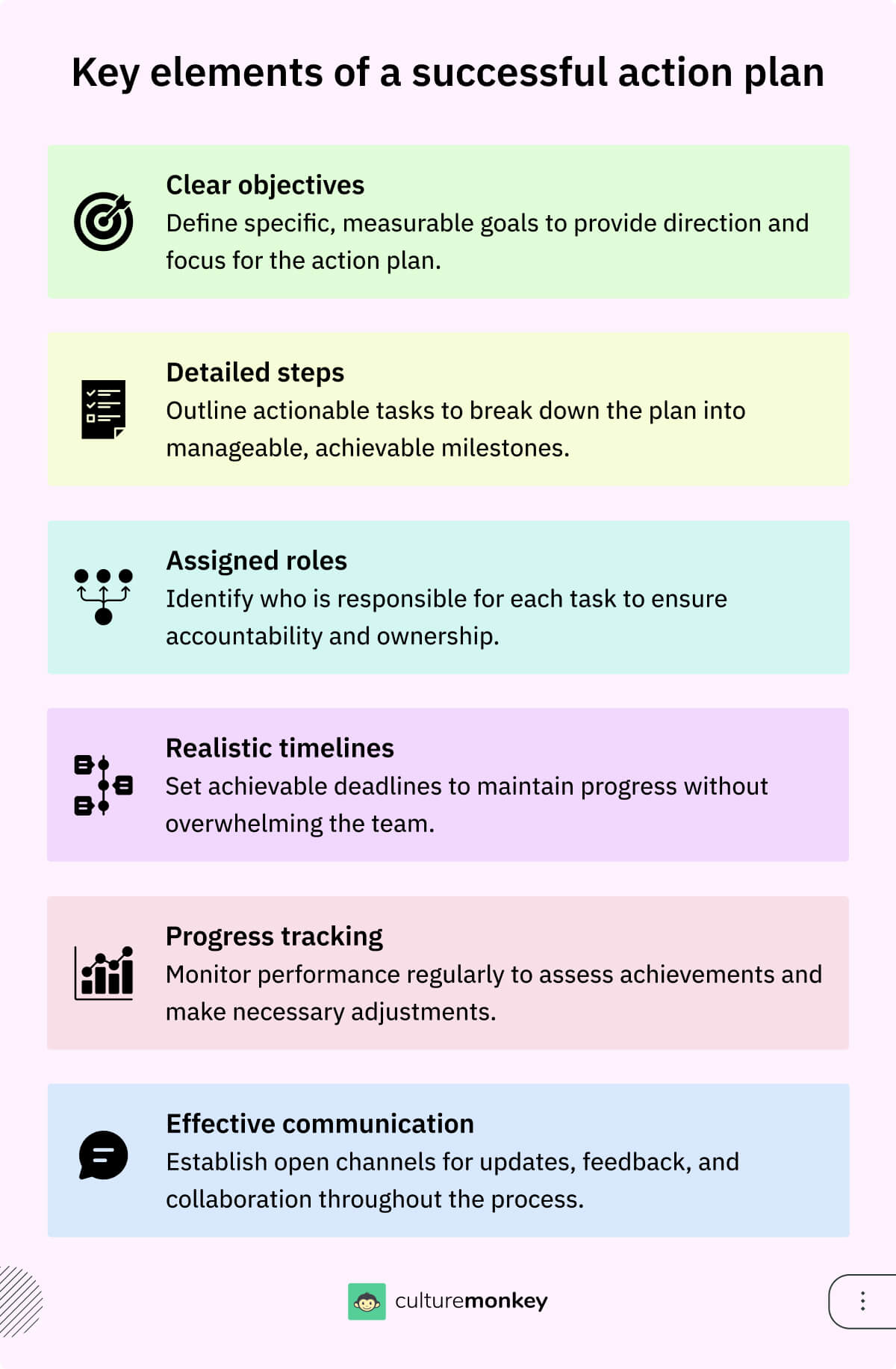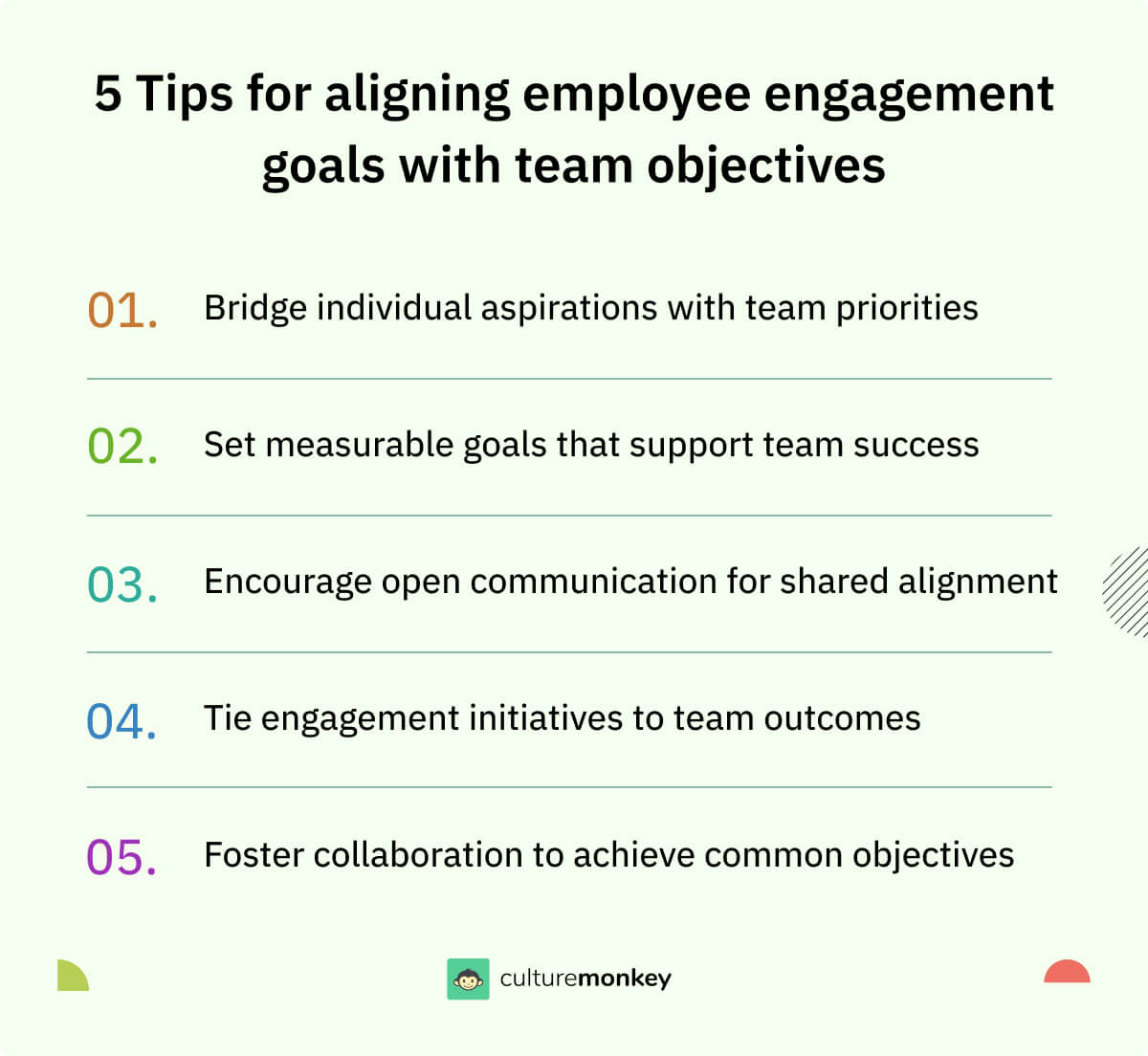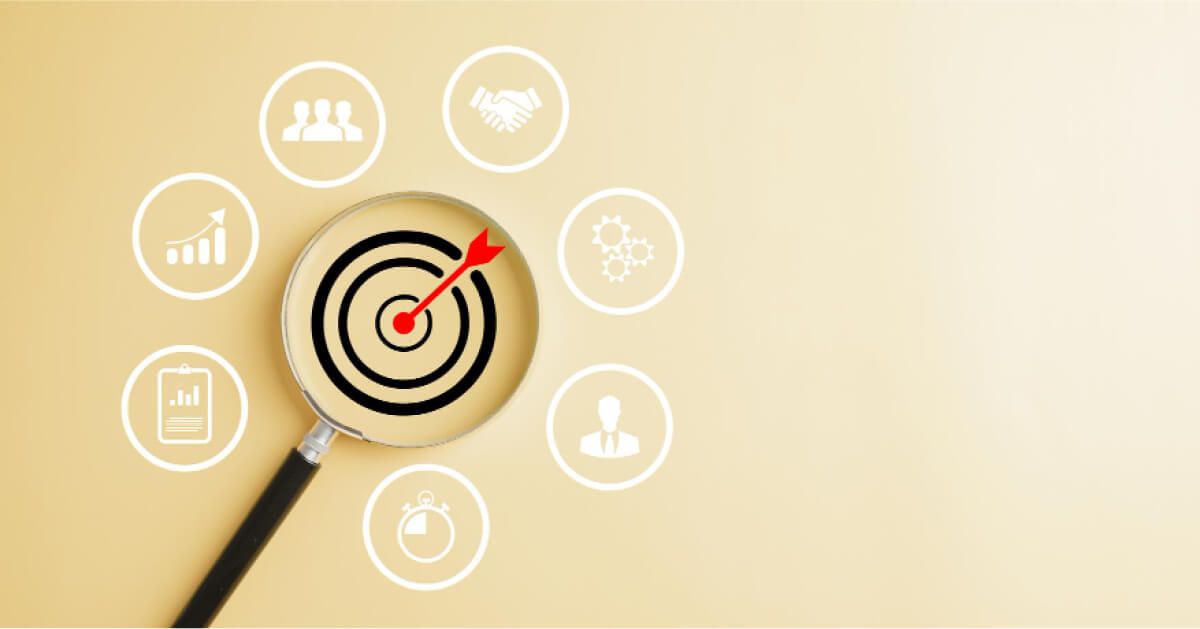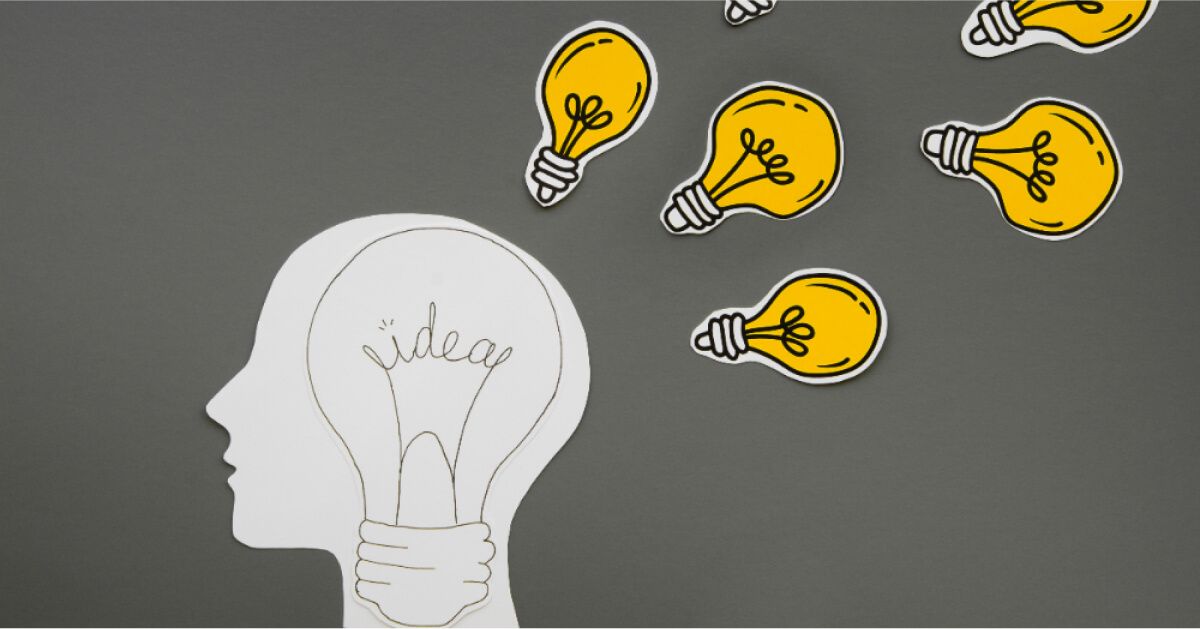Employee engagement goals: How to set and achieve them in 2025

Imagine your company is a sports team.
You’ve got talented players, top-notch equipment, and a big game coming up. But there’s no playbook, no strategy, and no clear goal. What happens? Chaos. Players run in every direction, nobody knows their role, and the scoreboard? A disaster. Now, think of your employees as that team. Without clear engagement goals, even the most skilled individuals will struggle to align, collaborate, and perform at their best.
Employee engagement goals are your company’s playbook—they give your team direction, purpose, and a shared vision to win. When everyone knows their role and what they’re working toward, that’s when the magic happens.
In this blog, we’ll dive into actionable strategies to set employee engagement goals that bring focus, energy, and results to your workplace. Let’s get your team back in the game.
Blog Highlights


What employee engagement is—and is not?

Employee engagement is the key to transforming your workforce into a motivated, high-performing team.
It’s not about superficial perks, longer hours, or one-off team-building events. True engagement comes from creating an environment where employees feel valued, challenged, and inspired to contribute their best every day.
Engagement isn’t a one-size-fits-all solution. What motivates one person might not work for another, and short-term fixes like free lunches or occasional rewards won’t create lasting commitment. Instead, it’s about building a culture of purpose, trust, and growth where employees are truly invested in their work and the organization’s success.
When you prioritize employee engagement, you unlock higher productivity, stronger collaboration, and a team that’s driven to excel. It’s a long-term strategy, not a quick fix—and it’s the difference between employees who show up and those who thrive.



Everyone talks about building a relationship with your customer. I think you build one with your employees first.
Former Senior Vice President
Apple
How does employee engagement differ from job satisfaction?

| Aspect | Employee engagement | Job satisfaction |
|---|---|---|
| Definition | Emotional investment and enthusiasm toward work. | Contentment with the job and work conditions. |
| Behavior | Proactive, innovative, and goes above and beyond. | Meets expectations, focuses on assigned tasks. |
| Impact | Drives innovation, improves processes, and boosts company success. | Maintains stability and consistency in the workplace. |
| Connection to work | Strong alignment with company goals and values. | Comfortable with the role but not always aligned with broader goals. |
Why is employee engagement important?

An engaged workforce creates a ripple effect that boosts productivity, retention, culture, and growth. Here’s why it matters:
- Enhanced productivity: Engaged employees bring passion, creativity, and focus to their work, leading to higher efficiency and better results.
- Improved retention: Employees who feel valued are more loyal, reducing turnover and the costs of hiring and training new talent.
- Positive company culture: Engagement fosters collaboration, trust, and morale, creating an environment where teams thrive and support each other.
- Higher customer satisfaction: Engaged employees go the extra mile, ensuring exceptional service that leads to happier customers and repeat business.
- Innovation and growth: Enthusiastic employees embrace change and drive innovation, helping your company stay agile and competitive in a dynamic market.
Components of effective engagement goals
Effective engagement goals are built on clear components that ensure they are actionable, impactful, and aligned with organizational success. Here are the key elements:
- Specificity and clarity: Engagement goals must be precise and clearly defined. Vague goals like "improve team morale" are ineffective. Instead, set specific goals such as "increase team feedback participation by 20% over the next quarter." This eliminates ambiguity and provides a focused direction.
- Alignment with organizational values: Goals must reflect the organization’s core values and culture. For example, if collaboration is a value, a goal might involve implementing team-based projects or improving interdepartmental communication. This alignment reinforces the organization’s mission and identity.

- Employee-centric focus: Effective goals are designed with employees in mind. Incorporating employee feedback ensures goals address real concerns, aspirations, and needs. This bottom-up approach fosters ownership and increases motivation to achieve them.
- Measurable outcomes: Successful engagement goals include quantifiable metrics to track progress. Whether it’s survey scores, participation rates, or retention data, measurable outcomes ensure accountability and allow for ongoing evaluation.
- Flexibility and adaptability: Engagement strategies must remain flexible to adapt to changing business dynamics or employee needs. Goals should be revisited periodically to assess relevance and effectiveness.
- Recognition and rewards integration: Integrating recognition into engagement goals motivates employees to actively participate. Celebrating milestones and contributions helps reinforce progress and maintain momentum.
Types of employee engagement

It's time to explore the different types of engagement you might encounter in your workplace. So, let's dive into the quirky world of employee engagement types:
- The cheerleaders: These employees are the enthusiastic cheerleaders of your organization. They are always upbeat, spreading positivity and motivation to their colleagues. With their infectious energy, they boost team spirit, organize fun activities, and radiate enthusiasm wherever they go. You can spot them in the office, rallying the troops and keeping morale high.
- The quarterbacks: Just like the quarterbacks on the football field, these employees are natural leaders. They take charge, make strategic decisions, and guide their teams toward success. These individuals possess excellent communication skills, inspire others to perform at their best, and excel at motivating their colleagues to achieve shared goals.
- The MVPs (Most Valuable Players): Engaged employees consistently bring their A-game to work daily, and their dedication and exceptional skills make them stand out. Recognize and celebrate these MVPs, as they are the driving force behind your organization's success.
- The team players: Employees thrive on collaboration and teamwork. They actively seek opportunities to collaborate, share knowledge, and help their colleagues succeed. Their cooperative mindset fosters a sense of unity and camaraderie within the organization.
- The innovators: These employees are creative thinkers and problem solvers. They continuously seek ways to improve processes, come up with innovative solutions, and push the boundaries to drive the organization forward. Innovators are not just satisfied with the status quo; they are always on the lookout for new and better ways to do things, and they inspire their colleagues with their fresh ideas.
- The mentors: Mentors play a crucial role in employee growth and development. They willingly share their knowledge and experience, guiding newer team members through the ropes and helping them advance in their careers. These individuals are patient, empathetic, and committed to the success of their colleagues, making them invaluable assets in nurturing talent within the organization.
What are employee engagement goals?

Alright, let's now delve into the world of clear employee engagement goals. Think of these employee engagement strategies as the playbook that guides your team toward a victorious season. Just as football teams set targets to improve their game, we need to establish clear employee engagement goals to enhance organizations.
So, grab your helmets and get ready for these 12 pointers on employee engagement goals:
- Boost the spirit meter: Aim to create a positive and inclusive work environment that sparks joy and excitement. Encourage employee recognition, celebrate milestones, and organize team-building activities that make work feel like a touchdown celebration.
- Empowerment galore: Foster a sense of empowerment by providing employees with autonomy and decision-making opportunities. When individuals feel trusted and have ownership over their work, engaged and motivated employees are more likely to excel.

- Champion growth and development: Set company goals to support your employees' professional and personal growth. Offer training programs, mentorship opportunities, and career advancement paths to help them level their skills and reach their full potential.
- Communicate like a quarterback: Establish effective communication channels that keep everyone in the loop. Provide regular feedback, conduct transparent town hall meetings, and create open-door policies that encourage dialogue and collaboration.
- Flexibility formation: In today's world, work-life balance is more crucial than ever. Set goals to promote flexibility, such as remote work options, flexible scheduling, or alternative work arrangements that accommodate the diverse needs of your workforce.
- Wellness touchdown: Prioritize employee well-being by promoting a healthy work-life balance. Develop employee wellbeing programs, encourage breaks and self-care, and create a supportive environment that values mental and physical employee health.
- Collaborative game plan: Foster a culture of teamwork by setting goals that promote collaboration and cross-functional projects. Encourage departments to work together, break down silos, and create a sense of shared purpose.
- Fun and playful drives: Inject fun and playfulness into the workplace. Set goals to organize recreational activities, team outings, and quirky events that ignite laughter and strengthen bonds among your employees.
- Innovation blitz: Fuel innovation by setting goals that encourage creative thinking and idea generation. Create platforms for employees to share their ideas, implement suggestion programs, and recognize innovative contributions.
- Continuous pulse check: Establish goals to measure and assess employee engagement levels regularly. Conduct regular pulse checks, hold focus groups, and gather feedback to understand what's working and identify areas for improvement.
- Enhanced recognition culture: Develop a culture of continuous recognition by setting goals to regularly acknowledge and reward employees for their hard work and achievements. Implement an employee recognition program that appreciates their contributions, no matter how big or small.
- Flexible work arrangements expansion: Extend the scope of flexibility by setting goals to provide more diverse work arrangements. Offer compressed workweeks, job sharing, and extended parental leave options to accommodate various employee needs and lifestyles.
How to set employee engagement goals?

Setting employee engagement goals is crucial to creating a motivated and high-performing workforce. Clear, strategic goals align employees with the company’s mission while fostering a sense of purpose and ownership. Here’s how to set effective employee engagement goals:
- Align goals with organizational objectives: Start by understanding your company’s larger goals. Employee engagement initiatives should support business priorities such as improving productivity, reducing turnover, or driving innovation. This alignment ensures a shared sense of purpose and direction.
- Make goals specific and measurable: Vague goals lead to vague results. Instead of saying “improve engagement,” set measurable targets. Clear metrics allow you to track progress and make data-driven adjustments.
- Involve employees in goal-setting: Engagement thrives when employees feel involved. Conduct surveys, hold team discussions, and encourage employees to share what motivates them. Collaborative goal-setting gives employees a sense of ownership and increases commitment.
- Focus on professional development: Employees are more engaged when they see opportunities to grow. Set goals around training programs, mentorship opportunities, or career advancement paths that align personal growth with organizational success.
- Prioritize communication and feedback: Create goals to improve two-way communication. Encourage managers to conduct regular one-on-one check-ins and implement structured feedback systems to show employees their opinions matter and actions follow.
- Recognize and reward progress: Set goals for creating a culture of recognition. Celebrating achievements—both big and small—keeps employees motivated and reinforces engagement efforts.
Challenges in setting and achieving engagement goals
Setting and achieving employee engagement goals is critical for organizational success, but it comes with its own set of challenges. Here are some key challenges to consider:
- Lack of alignment with business objectives: One major challenge is setting engagement goals that do not align with the company’s broader mission and priorities. Goals must directly support organizational objectives to ensure relevance and measurable impact.
- Insufficient employee input: Engagement goals often fail because they are set without understanding employees’ perspectives. Ignoring employee feedback can lead to goals that lack relevance, buy-in, or motivation, making them harder to achieve.
- Inconsistent measurement and tracking: Without clear metrics and tracking systems, it becomes difficult to monitor progress. Inconsistent evaluation leads to vague results, making it hard to determine whether the goals are being met or if adjustments are needed.
- Resource and time constraints: Organizations often underestimate the resources—time, budget, and tools—needed to implement engagement initiatives effectively. Without proper support, engagement efforts may stall or lose momentum.
- Resistance to change: Employees and leaders alike may resist new engagement strategies, especially when they require significant behavioral or cultural shifts. Overcoming this resistance requires clear communication and leadership buy-in.
- One-size-fits-all approach: Applying generic engagement goals to all departments or individuals can be counterproductive. Tailoring goals to specific teams or demographics ensures better alignment and results.
What are employee engagement objectives in the long run?

Employee engagement objectives in the long run focus on creating a sustainable and thriving workplace culture that benefits both employees and the organization.
- Fostering leadership development: Long-term engagement requires strong leadership. An objective should be to identify and nurture future leaders from within your workforce. Investing in leadership development programs helps retain top talent and ensures a pipeline of capable leaders aligned with your company’s values.
- Building a culture of continuous learning: Organizations must prioritize lifelong learning. Set objectives to offer ongoing skill development opportunities, workshops, and access to new technologies. This keeps employees engaged, adaptable, and prepared for evolving industry demands.
- Strengthening organizational loyalty: Long-term objectives should focus on building emotional connections between employees and the company. Creating a sense of pride, trust, and belonging ensures employees stay loyal, reducing turnover and strengthening the workforce.
- Promoting work-life balance: Sustainable engagement depends on employee well-being. Set goals to implement long-term strategies such as flexible work schedules, mental health initiatives, and wellness programs to support a healthy work-life balance.
- Driving innovation and adaptability: A key objective is fostering a culture where employees feel empowered to innovate. Encourage risk-taking, idea-sharing, and experimentation to ensure the organization stays competitive and agile in a rapidly changing market.
What are smart goals for employee engagement?

Smart goals for employee engagement are the guiding principles that help organizations focus their efforts on fostering a motivated, productive, and satisfied workforce. Let's delve into what makes a goal "smart" in the context of employee engagement.
- Specific: Your goals should be crystal clear. Instead of a vague aim like "improve employee morale," set a specific goal like "implement a monthly recognition program to acknowledge outstanding contributions."
- Measurable: Make sure you can track progress. Define the metrics you'll use to assess success. For instance, "Increase employee satisfaction scores by 10% in the next quarter."
- Achievable: Goals should be challenging but realistic. Setting unattainable targets can demotivate employees. Ensure that the goal can be reached with the available resources and effort.
- Relevant: Ensure your goal aligns with your company's values and mission. If your organization values work-life balance, a goal to reduce overtime aligns well.
- Time-bound: Set a deadline. Without a timeframe, goals can linger indefinitely. "Roll out a mentorship program by the end of the year" gives you a clear endpoint.
15+ Employee engagement goal ideas for 2025

Let's dive into a list of 15+ creative employee engagement goal ideas to spice up our playbook for 2025. Get ready to tackle these pointers head-on.
- Fun and frolic Fridays: Set a goal to organize weekly themed activities or dress-up days to inject fun and excitement into the workplace, turning Fridays into a celebration of joy and camaraderie.
- Mentorship mayhem: Establish a goal to implement a mentorship or an employee engagement program where experienced employees can guide and support their colleagues, fostering a culture of continuous learning and growth.
- Feedback frenzy: Make it a goal to promote a culture of feedback and open communication. Encourage employees to provide constructive feedback to their peers, managers, and upper management, fostering a culture of trust and improvement.
- Remote work revolution: In this era of flexible work, set a goal to enhance your remote work policy further. Encourage virtual team-building activities, provide necessary resources, and create a supportive virtual environment for remote employees.
- Innovation jam: Create a goal to hold regular innovation sessions or "jam" sessions where employees can brainstorm and share creative ideas for process improvements, new products, or innovative solutions to company challenges.
- Community involvement crusade: Make it a goal to organize community service or volunteering opportunities for your team. Give back to the community and create a sense of purpose and fulfillment by engaging employees in meaningful employee engagement initiatives.
- Wellness warrior challenge: Establish a goal to introduce wellness challenges or competitions, such as step challenges, mindfulness programs, or healthy cooking contests, to inspire employees to prioritize their well-being.
- Diversity and inclusion dance-off: Set a goal to actively promote diversity and inclusion in the workplace. Organize diversity training, create employee resource groups, and celebrate different cultures to foster a truly inclusive environment.
- Gratitude game: Make it a goal to encourage gratitude practices within your organization. Implement a gratitude board where employees can express their appreciation for their colleagues' contributions and acts of kindness.
- Personal development power hour: Set a goal to dedicate time each week for employees to focus on personal development. Encourage them to pursue courses, attend webinars, or read books to enhance their skills and knowledge.
- Team-building timeouts: Establish a goal to schedule regular team-building activities, both in-person and virtual, to strengthen bonds and foster a sense of belonging within your teams.
- Flexibility fling: Make it a goal to offer flexible work arrangements beyond remote work. Allow employees to customize their schedules, whether it's adjusting start and end times or adopting alternative work arrangements to accommodate personal needs.
- Recognition rumble: Set a goal to create a culture of appreciation and recognition. Implement a system where employees can acknowledge and celebrate their peers' achievements, whether it's through shout-outs, awards, or public recognition.
- Skill swap sessions: Organize regular “skill swap” sessions where employees teach one another skills they excel at, both professional and personal. Whether it’s coding tips, marketing strategies, or photography basics, this fosters knowledge sharing, builds cross-department relationships, and promotes personal growth.
- Shadowing spotlight: Implement a job-shadowing initiative where employees can spend time observing colleagues from different roles or departments. This provides fresh perspectives, enhances understanding of company operations, and encourages collaboration across teams.
- Passion project pitch: Allow employees to dedicate time to pitch and work on passion projects that align with company goals. Whether it’s a creative campaign idea, process improvement, or product innovation, this empowers employees to take ownership and contribute in meaningful, fulfilling ways.
- Town hall transparency: Set a goal to hold monthly or quarterly town hall meetings where leadership transparently shares updates, challenges, and company progress. Encourage Q&A sessions to give employees a platform to voice concerns, ideas, or suggestions, fostering trust and inclusivity.
Effective employee engagement strategies

engaged employees are your most valuable asset. They're more productive, less likely to leave, and highly committed to your organization's goals. They're also your best brand ambassadors, speaking positively about your company to friends and family. In short, they're a key ingredient in your success recipe.
But don't expect overnight miracles. Building and maintaining employee engagement is an ongoing process that requires genuine commitment. It's not about following a checklist but rather embracing a culture that values its people.
Here are 11 strategies to boost employee engagement and set your organization on the path to success:
- Purposeful onboarding: Engage your employees right from the start. A structured onboarding process that introduces them to your company's culture, values, and their role within the organization can make a world of difference.
- Clear communication: Maintain open, transparent communication channels. Regular meetings, one-on-ones, and feedback sessions help employees feel heard and valued.
- Skill development: Invest in your team's growth. Offering opportunities for skill development and career advancement will not only keep them engaged but also benefit your company.
- Recognition and rewards: Recognize and reward your employees for their hard work. Everyone appreciates a pat on the back, and it goes a long way in boosting morale.
- Flexible work arrangements: In today's world, flexibility is key. Offer options for remote work, flexible hours, or compressed workweeks to cater to diverse employee needs.
- Wellness programs: A healthy employee is a happy employee. Consider wellness programs that promote physical and mental well-being, from gym memberships to mindfulness workshops.
- Empowerment: Give your employees a sense of ownership. Allow them to have a say in decision-making and trust them to take on responsibilities.
- Team building: Organize team-building activities to foster a sense of camaraderie. A close-knit team is often a more engaged and productive one.
- Mentorship and coaching: Pair experienced employees with newcomers for mentorship. This helps in knowledge transfer and gives new hires a support system.
- Regular feedback: Continuous feedback is crucial. Set up regular performance evaluations, and encourage a culture of constructive feedback.
- Celebrate milestones: Recognize personal and professional milestones. Whether it's birthdays, work anniversaries, or project successes, celebrations create a positive atmosphere.
Employee engagement goals examples
Employee engagement isn't just about what you say; it's about what you do. When you set clear, achievable goals, you're taking the first step toward a more engaged and motivated workforce.
Here are some inspiring employee engagement goals that can transform your organization
- Enhanced learning and development: One of the most empowering goals you can set is to foster continuous learning. Encourage your team to seek new skills, whether it's through workshops, online courses, or mentorship programs. This goal not only benefits individual growth but also translates into a more skilled and motivated workforce, ready to take on new challenges.
- 360-degree feedback: Make feedback a two-way street. Aim to implement a 360-degree feedback system where employees can provide input not only on their superiors but also on the organization as a whole. This goal promotes a culture of open communication, ensuring that everyone's voice is heard and respected.
- Innovative idea generation: Challenge your employees to think outside the box. Encourage them to come up with innovative ideas that can improve processes or products. Recognize and reward these ideas, fostering a culture of creativity and empowerment.
- Diversity and inclusion initiatives: Set a goal to create a more diverse and inclusive workplace. This might involve implementing policies that promote diversity in hiring, forming employee resource groups, and providing training on unconscious bias. A diverse workforce brings different perspectives to the table, fostering creativity and empathy.
- Work-life balance support: Prioritize the well-being of your employees by focusing on work-life balance. Set goals to reduce overtime, encourage vacations, and promote a culture where employees can disconnect after work hours. When employees feel their personal lives are valued, they're more likely to be engaged at work.
- Employee-led initiatives: Empower employees to lead projects or initiatives they’re passionate about. Whether it’s organizing team events, launching sustainability programs, or spearheading process improvements, giving employees ownership fosters a sense of responsibility, pride, and engagement in their work.
- Recognition and career pathing: Set a goal to create clear career development pathways and regularly recognize employee progress. Implement personalized development plans and celebrate milestones like promotions, certifications, or project successes. This ensures employees see a future within the organization, boosting motivation and long-term commitment.
Things to consider with employee engagement strategies
Employee engagement strategies are like the gears in a well-oiled machine; they keep your workforce motivated, productive, and loyal. However, there's more to it than just implementing strategies. Let's talk about some crucial considerations you should keep in mind when crafting and executing these strategies.
- Tailor to your team: Your employees are unique, and so should your strategies be. What motivates your sales team might not work for your IT department. Consider the specific needs and preferences of your employees and adapt your engagement strategies accordingly.
- Consistency is key: Employee engagement isn't a one-time effort. It's an ongoing process. So, be consistent in your approach. Regular communication, feedback, and recognition should be part of your daily routine, not just occasional events.
- Leadership buy-in: Your leaders need to champion employee engagement. If your senior management isn't on board, it's tough to create a culture of engagement. Ensure they understand its importance and actively support your strategies.
- Clear communication: Effective communication is the backbone of any successful engagement strategy. Ensure your messages are clear, transparent, and easily accessible. Regularly update your team on company news, goals, and performance.
- Employee involvement: Don't just hand down engagement strategies from the top; involve your employees in the process. Seek their input, ask for feedback, and encourage them to take ownership of their engagement.
- Feedback loop: Two-way feedback is essential. Ensure that employees have the opportunity to provide feedback on their experiences, concerns, and suggestions. Act on this feedback to demonstrate that their voices are valued.
- Measure progress: How will you know if your engagement strategies are working if you don't measure their impact? Use surveys, performance metrics, and employee turnover rates to gauge the effectiveness of your initiatives.
- Flexibility and adaptability: The world is constantly changing, and so are the needs and expectations of your employees. Be ready to adapt your strategies to meet these evolving demands. Stay agile and open to change.
- Long-term vision: Think beyond short-term gains. Consider how your strategies will impact employee engagement in the long run. Will they contribute to a sustainable, positive culture within your organization?
Employee engagement roles: Who should be involved?

Employee engagement is a team effort, and it involves a cast of characters from various roles and levels within an organization. Let's take a look at who should be involved in fostering employee engagement and the unique roles they play in creating a motivating work environment.
- Leaders and executives: At the top of the pyramid, leaders and executives are the visionaries. They set the tone for the organization's culture and values. Their role in employee engagement is to champion engagement initiatives, lead by example, and ensure that engagement is integrated into the company's strategic planning.
- Human Resources (HR): HR professionals are the conductors of the engagement orchestra. They play a central role in designing and implementing engagement programs. They handle everything from onboarding to performance reviews, making sure that the employee experience is positive and aligned with the organization's goals.
- Managers and supervisors: Frontline managers and supervisors are the immediate influencers. They interact with employees on a daily basis and play a crucial role in creating a motivating work environment. Their job is to provide feedback, support career development, and recognize and reward their team's efforts.
- Employees themselves: Employee engagement isn't a one-sided effort; employees themselves play a pivotal role. They need to actively participate, communicate their needs and expectations, and engage in company initiatives and activities.
- Internal communications specialists: Communication is the key to engagement. Internal communications specialists are responsible for ensuring that important information is disseminated effectively. They play a significant role in keeping employees informed and connected.
- Training and development teams: The training and development teams are essential in helping employees build the skills and knowledge needed to excel in their roles. Continuous learning opportunities are a key driver of engagement.
- Diversity and inclusion officers: In today's diverse workplaces, these officers help create an inclusive environment where every individual feels valued and has an equal opportunity to contribute. Inclusion fosters engagement and innovation.
- Wellness and health promotion specialists: Employee well-being is closely linked to engagement. Specialists in this area create programs and initiatives that promote physical and mental health, contributing to a more engaged workforce.
- Project and team leaders: When it comes to specific projects and teams, project and team leaders play a crucial role in keeping team members engaged, motivated, and on track. They set the tone for the team's culture.
Conclusion
Setting meaningful employee engagement goals is essential for building a motivated, productive, and committed workforce. By establishing clear, actionable objectives, organizations can foster a positive culture, boost morale, and drive long-term success.
CultureMonkey’s innovative employee experience platform is designed to streamline the process of setting and achieving employee engagement goals. With its robust tools for real-time feedback collection, customizable surveys, and actionable insights, CultureMonkey empowers organizations to identify what truly motivates their teams.
What sets CultureMonkey apart is its focus on continuous engagement and improvement. Beyond gathering employee input, it provides data-driven recommendations to help you implement impactful strategies and track progress effectively.
With real-time reporting and analytics, you can measure the success of your engagement efforts and make informed decisions that create a thriving workplace culture.
Take your employee engagement goals to the next level with CultureMonkey—transform feedback into meaningful actions that drive growth and success for your organization.
Summary
Leadership-focused employee survey questions are essential for fostering a culture of accountability and trust. By gathering actionable feedback, organizations can pinpoint leadership strengths, address challenges, and align leadership behaviors with employee expectations.
This process enhances communication, strengthens relationships, and motivates teams to perform at their best. Leveraging leadership-focused surveys drives improved performance and ensures sustained organizational success.
FAQs
1. How do engagement goals impact workplace productivity?
Engagement goals create a motivated workforce by fostering purpose, alignment, and satisfaction. When employees feel valued and connected to organizational objectives, they become more focused, proactive, and efficient. This directly boosts productivity, improves collaboration, reduces errors, and enhances innovation, resulting in better overall performance, measurable outcomes, and a thriving workplace culture for the organization.
2. How can organizations set measurable engagement goals?
Organizations should define clear, specific goals aligned with business objectives and employee needs. Use measurable metrics such as employee survey scores, participation rates, or retention data. For example, "increase employee feedback survey participation by 15% in 6 months." Measurable goals ensure accountability, provide clarity, and allow progress to be tracked effectively for continuous organizational improvement.
3. How can organizations balance long-term and short-term engagement goals?
Organizations can balance both by setting immediate, actionable goals (e.g., improving team communication) while aligning them with long-term objectives like fostering leadership or improving retention. Regularly evaluate progress, ensuring short-term wins contribute to sustainable cultural and operational growth over time. This approach keeps employees motivated, engaged, and focused while consistently driving organizational success toward bigger milestones.
4. How often should employee engagement goals be revisited?
Employee engagement goals should be revisited quarterly or biannually. Regular check-ins allow organizations to assess progress, adapt to changing needs, and ensure goals remain relevant. Feedback surveys and performance reviews can provide insights to refine strategies, address challenges effectively, celebrate achievements, and maintain continuous improvement in engagement efforts, ultimately fostering a motivated and high-performing workforce aligned with organizational objectives.
5. How do you prioritize engagement goals for different teams?
Prioritize goals based on team-specific needs, challenges, and objectives. Gather employee feedback, assess performance metrics, and align goals with each team’s role in organizational success. For instance, a customer-facing team may prioritize communication skills, while a product team might focus on fostering innovation and creativity. Regularly revisiting these goals ensures continuous alignment, measurable progress, and sustained team motivation for long-term success.




